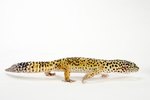
In general, uromastyx are hardy reptiles who have relatively straightforward care requirements. Niger uromastyx (Uromastyx geyri) -- sometimes called Saharan uromastyx -- are a popular choice given their moderate size and bold coloration. Wild caught uromastyx are not appropriate pets for beginners, and are likely to perish. However, captive bred specimens are likely to thrive if you provide them with a spacious enclosure, proper environmental conditions, good hiding locations and you feed them correctly.
Spacious Enclosures
A number of cage styles are acceptable, including stock tanks, aquariums and commercial cages; however, the most important aspect of the cage is its size. While juvenile Niger uromastyx only require 2 or 3 square feet of space, adults require at least 8 square feet, and they will use and appreciate even larger cages. Opposite-sex cage mates cohabitate well in most cases, but same-sex pairings are not often harmonious. You can house juveniles in small groups.
Simulating the Sun
Uromastyx are sun-loving lizards who require very warm basking temperatures and high-quality light. Use a reflector dome and incandescent bulb or mercury vapor lamp to create a basking spot. Place several flat, smooth stones under the basking lamp. The surface temperatures in the basking area should be about 110 to 120 degrees Fahrenheit. The temperature should drop with increasing distance from the basking light, allowing the lizard to adjust his temperature as necessary. In addition to the basking lamp, use a full spectrum fluorescent light to illuminate the cage. The necessity of UVB radiation for vitamin D3 production has not been conclusively determined for this species; in the absence of concrete data, use light bulbs that do produce UVB if you cannot give your pet regular access to unfiltered sunlight.
Substrate and Furnishings
Some keepers elect to replicate the natural habitat of Niger uromastyx and provide a soil substrate, which allows the lizards to dig tunnels. However, this strategy can cause unnecessary problems for new keepers. A simpler solution is to provide your pet with numerous hide boxes or tubes and use newspaper as a substrate. Alternatively, some keepers choose to use a ¼ inch layer of birdseed as a substrate; you can sift birdseed to clean it, and while some substrates represent a potential impaction hazard, birdseed is a regular component of your lizard’s diet. Plastic pipes, flat boards, commercial hide boxes and inverted clay flowerpots make excellent hiding locations -- the ideal hiding location is snug, and allows your uromastyx to contact the “ceiling” of the hide box with his back.
Food and Water
Uromastyx are largely herbivorous, and primarily consume vegetation and seeds. Feed your uromastxy a rotation of leafy greens, seeds, beans and vegetables. Bok choy, collard greens, shredded carrots, squash, zucchini, green beans, Swiss chard, peas, mustard greens, birdseed and turnip greens are excellent dietary staples. Feed your uromastyx vegetables and a small amount of seed five to seven times per week. While uromastyx often accept insects as food -- it is important that insects only represent occasional treats. Use both a vitamin and calcium supplement regularly -- consult with your veterinarian to devise a proper supplementation schedule. Your lizard will obtain most of his water from his food, but you can include a very small water dish in his cage. Many keepers offer water periodically, though healthy and well-fed Niger uromastyx do not often drink.
References
Photo Credits
-
Jupiterimages/Photos.com/Getty Images



